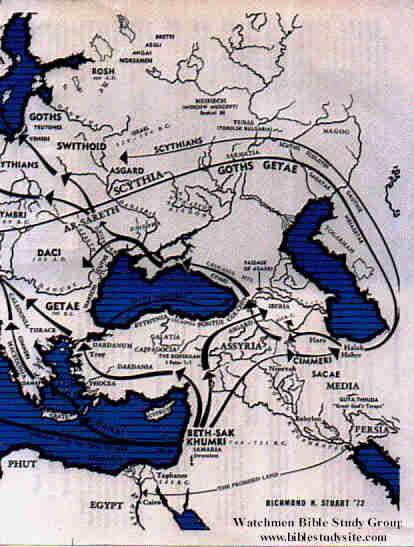Israelite Migrations - Part 2
THE DIASPORA OF ISRAEL
By Pastor Jim Jester
October 20, 2019
Scripture Reading: Genesis 28:10-16
“So Jacob went out from Beer-sheba to go to Haran. And coming to a certain place, he made it his resting-place for the night, for the sun had gone down; and he took one of the stones which were there, and putting it under his head he went to sleep in that place. And he had a dream, and in his dream he saw steps stretching from earth to heaven, and the angels of God were going up and down on them. And he saw the Lord by his side, saying, I am the Lord, the God of Abraham your father, and the God of Isaac: I will give to you and to your seed this land on which you are sleeping. Your seed will be like the dust of the earth, covering all the land to the west and to the east, to the north and to the south: you and your seed will be a name of blessing to all the families of the earth. And truly, I will be with you, and will keep you wherever you go, guiding you back again to this land; and I will not give you up till I have done what I have said to you. And Jacob, awaking from his sleep, said, Truly, the Lord is in this place and I was not conscious of it.” – BBE
Introduction
Most of the judeo-Christian world has heard very little about the captivities of ancient Israel. Most of their pastors are aware of the split of the kingdom of Israel resulting in the northern kingdom of Israel and the southern kingdom of Judah. They are also aware of the captivity of each of these kingdoms. However, since little is known, much is left to speculation and assumption. Few of them, and likewise their followers, are aware of the magnitude of the captivities and migrations of Israel and Judah. They assume [My response in brackets]:
- The population of Israel was relatively small, maybe in the thousands. [Actually, Israel was in the millions. According to I Chronicles 21:5, King David (about 1010 B.C.) could field over a million and a half men! This number did not include women, children, elderly or the maimed. We can only imagine how massive the total population was at the time.]
- Since Israel and Judah were in “captivity”, the impression is that they were penned up somewhere as if in a jail. [Actually, they were “captive” i.e., “in bondage to” another king.]
- Since they were “captive”, certainly they could not have gone anywhere unless set free. [There is no concept of a migration.]
- That most of the Israelites simply died off. [A violation of God’s promise to Abraham. “They shall fear thee as long as the sun and moon endure, throughout all generations.” – Ps. 72:5, etc.]
A question I like to ask when someone says the Israelites either “died off” or were “lost” from history is this. How can millions of people simply die off or get lost? How can millions just suddenly become extinct? Did the Earth just open up and swallow them? Did Scotty beam them up?
The popular church does not seem to pay much attention to their own publications:
“The main diaspora began in the 8th–6th centuries BC, and even before the sack of Jerusalem in AD 70. The number of Jews [sic] dispersed by the diaspora was greater than that living in Israel. Thereafter, Jews [sic] were dispersed even more widely throughout the Roman world and beyond.” – ‘Diaspora’, from Apple Dictionary [brackets mine]
Of course, they have the wrong people identified. “Jews” is the wrong term because the main dispersion was Israel (northern kingdom) of the ten tribes. Afterwards (before 70 AD), Judeans (or Judahites and Benjaminites) of the southern kingdom (also Israelites) were captured.
At the time of King David’s death (970 B.C.), Israel had become an ancient super-power with the Phoenicians as their ally, not an obscure people stuck in the small land of Palestine. They were the dominant power with huge military resources, advanced technology, control over land and sea trade routes, and a close alliance with the dominant maritime power (Phoenicia) of that time. The Bible describes the interactions of the great powers of the ancient world, not insignificant events of a small population in Palestine.
The Judean historian, Josephus, knew the ten tribes of Israel existed,
“Wherefore there are but two tribes in Asia and Europe subject to the Romans, while the ten tribes are beyond Euphrates till now, and are an immense multitude, not to be estimated by numbers.” – Antiquities, XI, V, 2 [emphasis mine]
In the prophecy of Hosea (1:6-10) God said that He would “utterly take them away” (from Palestine); and yet after their removal would make them “as the sand of the sea, which cannot be measured or numbered.” Yahweh our God keeps His Word!
Scripture Exposition
Our Scripture reading said that the seed of Jacob/Israel would spread “west, east, north and south”; and it occurred in that order. It is evident that this spreading of Israelites in all directions must mean (at least) lands of quite a distance away, for it says, “…I will be with you, and will keep you wherever you go, guiding you back again to this land [the land on which Jacob was sleeping]….” This is strongly implied because Jacob’s descendants would be “as the sand of the sea” [an enormous population to fill this huge area]; and, that they would be “a name of blessing to all the families [Adamite families] of the earth.” None of this passage would make any sense if it were localized to only that small land of Palestine.
It is very important to understand something about the captivities and migrations of God’s chosen people (not “Jews”). This is why I have prepared these lessons:
- As a review and summary of Dr. Blanchard’s Bible Boot Camp.
- To thoroughly ‘cement’ this information into our minds.
- To equip us to better share this message with our racial brethren.
As a brief review of the last lesson, we recall that there were at least seven migrations of Israelites before Saul became the first king of Israel, 1097 B.C.:
- The Partholanians: Parthalon of Greece to Ireland, 2051 BC
- Darda: Founded Troy (before the Exodus), 1527 BC
- Cadmus: To Greece (year of the Exodus), 1493 BC
- Danaus: To Greece (year of the Exodus), 1493 BC
- The Tuatha de Danaan: To Ireland (after Exodus), 1468 BC
- The Milesians: Conquered Ireland, 1271 BC
- Brutus: King of Britain (after the Exodus), 1103 BC
Israelites were getting around, were they not? They were not extinct and did not die off, nor were they lost from history. They were only “lost” from the minds of the “Baal priests” of judeo-Christian pastors.
We continue now with the Diaspora of Israel (abridged from Dr. Blanchard’s, Book Two and “Bible Mastery Boot Camp”.)
Israelites Known as Khumri
The Assyrian Empire rose to prominence about 911 B.C. after national Israel had split into two kingdoms, the house of Israel and the house of Judah. During the reign of King Ahab of Israel, the son of King Omri, an alliance was made between Israel and Assyria. As the power of Assyria grew, they began to extract tribute from the kings of Israel. In the Assyrian records, they referred to the house of Israel as Bit-Khumri (house of Omri).
“The name ‘Omri’ became an established term in Assyrian documents to indicate the Israelite kings even after the death of Omri and his descendants… Assyrian annalists continue to refer to Israel as the ‘land of (the house of) Omri’ for a hundred years after the end of his dynasty.” – Gen. Ed. Paul J. Achtemeier, Harper’s Bible Dictionary, p. 729-730
The king of Assyria, Shalmaneser, recorded his victory over twelve kings, Jehu being one of them, on the Black Obelisk on the Tigris River in Turkey. Shalmaneser referred to King Jehu as “the son of Khumri” (i.e., son of Omri) on this obelisk, which depicts Jehu bowing to Shalmaneser.
It is a known fact that Israelites were called by many different names, depending on who was writing the history. This term, Khumri, referring to the house of Israel, was used by the Assyrian kings through the reign of Sargon (until 705 B.C.), and then it was never used again.
Captivities and Migrations
Because of the continual rebellion of the house of Israel, Yahweh divorced them and allowed them to be taken captive. This occurred in several stages.
745 B.C. – The capture of Reuben, Gad, half-tribe of Manasseh and all of Naphtali:
“And they transgressed against the God of their fathers, and went a whoring after the gods of the people of the land, whom God destroyed before them. And the God of Israel stirred up the spirit of Pul king of Assyria, and the spirit of Tilgathpilneser king of Assyria, and he carried them away, even the Reubenites, and the Gadites, and the half tribe of Manasseh, and brought them unto Halah, and Habor, and Hara, and to the river Gozan, unto this day.” – 1 Chr. 5:25-26
“In the days of Pekah king of Israel came Tiglathpileser king of Assyria, and took Ijon, and Abelbethmaachah, and Janoah, and Kedesh, and Hazor, and Gilead, and Galilee, all the land of Naphtali, and carried them captive to Assyria.” – 2 Ki. 15:29
These specific cities, to where the Israelites were taken, were just east of Assyria near Ecbatana and Lake Urmia (below the Caspian Sea).
The following historical reference matches the Israelites taken to this same area at this same time by the name of “Scythians”. In other words, the people called Scythians suddenly showed up at the same time the house of Israel was carried away captive in stages by three successive kings of Assyria.
“The Scythians did not become a recognizable national entity… before the eighth century B.C. By the seventh century B.C., they had established themselves firmly in southern Russia… Assyrian document place their appearance… on the shores of Lake Urmia in the time of King Sargon (722-706 BC), a date which closely corresponds with that of the establishment of the first group of Scythians in southern Russia.” – Tamara T. Rice, The Scythians, p. 19-20, 44
So, after 705 B.C. the Israelites were known as Scythians, not as Khumri.
About 724-720 B.C. – A second wave of Tuatha de Danaans (Dan, Danaus) to Ireland, the Simonii (Simeon) into Wales, and the Scythians into Arsareth. This was just before the fall of Samaria and the final destruction and deportation of the northern kingdom of Israel.
“The Tuatha de Danaans… came to a resolution of quitting the country for fear of falling into the hands of the Assyrians; accordingly they set out, and wandered from place to place till they came to Norway and Denmark, where they were received with great hospitality by the inhabitants… when the Tuatha de Danaans had continued for some time in this country, they thought fit to move, and look out for a new settlement; and they arrived in the north of Scotland where they continued seven years…and then they moved to Ireland.” – Keating, A General History of Ireland, p. 101, 104
It is interesting that the historical names of Ireland during this period were Iberne, Erne, and Hibernia, from the name “Heber”, the father of the Hebrews.
“It thus appears that the titles ‘Hibernia’ for Ireland, and ‘Hebrides’ for the Western Isles, are probably survivals of the ‘Iberia’ title for the primitive stock, which first peopled the British Isles in the Stone Age.” – L.A. Waddell, The Phoenician Origin of Britons, Scots and Anglo-Saxons, p. 137.
This, of course, is another connection between Israelite Hebrews and the lands into which they settled.
Another migration of Israelites fleeing from the Assyrians went to the Black Sea area, including Arsareth, and were called Scythians.
“Many of the people did not go into captivity, but evaded the calamity, going off with their flocks, and turning nomads… because these migrating Israelites had 220,000 armed escorts, one can estimate there were at least a million Israelites in this group of refugees when women, children and elderly are included in the total… As this large group of Israelites resettled in the Black Sea region, many factors identified them as Israelites. The region to the east of the Black Sea and north of Armenia came to be known as Iberia… The presence of the Hebrew name, Iberia, in the region north of Armenia verifies that this was an area of Israelite resettlement for those migrating there to escape the Assyrians.” – Collins, Israel’s Lost Empires, p. 113-114
This documentation shows many Israelites escaping captivity of the Assyrians by migrating to Ireland, Wales, and the Black Sea area.
718 B.C. – The fall of Samaria and second deportation of Israel to Assyria. King Sargon II of Assyria destroyed the city and took all the Israelites that remained.
“In the ninth year of Hoshea the king of Assyria took Samaria, and carried Israel away into Assyria, and placed them in Halah and in Habor by the river of Gozan, and in the cities of the Medes.” – 2 Ki. 17:6
Notice that the Israelites (called ‘Gimira’ and ‘Cimmerians’ by the Assyrians) were taken to the same cities as in the first deportation in 745 B.C.
710 B.C. – Assyria captures the cities of Judah:
“Now in the fourteenth year of king Hezekiah did Sennacherib king of Assyria come up against all the fenced cities of Judah, and took them.” – 2 Ki. 18:13
King Sennacherib’s account of this event is recorded on the Taylor Prism (a hexagonal pillar of stone), which is in the British Museum. It says, “Forty six strong walled cities… two hundred thousand, one hundred and fifty people, great and small, male and female, horses, mules, asses, camels, cattle and sheep without number.”
Now the entire deportation by Assyria included most of the house of Judah (Judah, Benjamin, Levi) along with the northern house of Israel (the other ten tribes). All thirteen tribes have been removed from their land. Only the city of Jerusalem remained. God spared a remnant.
 Around 700 B.C., these Cimmerians (Israelites) migrated out of Assyria and overran Phrygia (Turkey).
Around 700 B.C., these Cimmerians (Israelites) migrated out of Assyria and overran Phrygia (Turkey).“Phrygia is named as a country overran by Cimmerians… the Phrygians seemingly accepted the Cimmerians as divinely appointed overlords… Although historical records are somewhat sketchy, it is clear that the Cimmerians overthrew the kingdom of Phrygia shortly after 700 B.C. Since much of the Phrygian territory included most of the Black Sea coast west of the Halys River… the Cimmerians would have been spread over a large area of Asia Minor west of the Euphrates River, including the Trojan region.” – Raymond Capt, Missing Links Discovered in Assyrian Tablets, p. 125
Therefore, in this time period (841-700 B.C.) Israelites were known by these names: Khumri, Gimira, Cimmerians, Sacae and Scythians.
This map shows the bulk of the migrations of Israel covered in this lesson. Some of the smaller names are difficult to read [wish I could find a better map]. Notice Halah and Habor just below the Caspian Sea; Iberia between the Caspian and Black seas; Arsareth and Scythia above the Black Sea (as is Ukraine today); and Getae, Thrace and Troy above the Mediterranean Sea.
Scythian Israel
In covering the migrations of Israel and Judah, the Scythians will be a recurring theme. The following is from William Finck’s, “Classical Records of the Origin of the Scythians.”
In his Library of History at 2.43.1-5, Diodorus Siculus says of the Scythians: “But now, in turn, we shall discuss the Scythians who inhabit the country bordering upon India. This people originally possessed little territory, but later, as they gradually increased in power, they seized much territory by reason of their deeds of might and their bravery and advanced their nation to great leadership and renown. At first, then, they dwelt on the Araxes River, altogether few in number and despised because of their lack of renown; but since one of their early kings was warlike and of unusual skill as a general they acquired territory, in the mountains as far as the Caucasus, and in the steppes along the ocean and Lake Maeotis (the sea of Azov today) and the rest of that country as far as the Tanaïs River ... But some time later the descendants of these kings ... subdued much of the territory beyond the Tanaïs River as far as Thrace ... for this people increased to great strength and had notable kings; one whom gave his name to the Sacae, another to the Massagetae, another to the Arimaspi, and several other tribes received their names in like manner ...” (Loeb Library edition).
So while Diodorus described the naming of the various related Scythian tribes fancifully, he surely is accurate in the description of the origins and growth of these people, and corroborates Herodotus concerning their relationship and locations. The Araxes River was the ancient boundary between Media and Armenia. Herodotus, describing the Persian King Cyrus’ expedition against the Massagetae, describes the Caspian Sea, the Araxes River, which empties into it from the west, and the Caucasus Mountains which bind the Caspian there, and places Cyrus’ expedition in this very place. Herodotus describes the Massagetae: “In their dress and mode of living [they] resemble the Scythians”, and, as he says later that the Scythians carry, “their favorite weapon, the battle-axe” (Histories 1.201, 215). Later Herodotus describes the Persian King Darius’ expedition against the Scythians. To get there Darius crossed the Bosphoros, and then going through Thrace crossed the Danube to attack them (4.97). He also described how these Scythians had migrated into Europe from Asia (4.11, 48), as Diodorus tells us. He also says that the Scythians of the east, who were once subject to the Persians, the Scythians of the Caucasus mountains, and the Scythians of Europe were all related (7.64).
Herodotus says of the Scythians that “the Persians called them Sacae, since that is the name which they give to all Scythians” (7.64). Strabo says only that the Sacae are of Scythian stock (7.3.9), but elsewhere that the Däae, Massagetae, and Sacae are Scythians, and that the inhabitants of Bactriana and Sogdiana (districts which border India), if not Scythians themselves, are ruled over by Scythians, and also that the Asii, Tocharians, and Sacarauli (found east of the Caspian near to Tibet) appear to be Scythians (11.8.2). Note the occurrence of the “saka” sound in so many names related to the Scythian tribes, such as Arsaces, Massagetae, Sacarauli, and also Sacasene as we shall see below.
There was no “Armenia” in the time of the Assyrian deportations of the Israelites. It is apparent that the name may have evolved from a Hebrew phrase meaning “mountain regions” (see Strong’s Hebrew lexicon #’s 2022, 4480 and 4482). In earlier times, the land was partly occupied by the Urartu, who seem to be related to the Medes, and the upper portions by the Moschi and Tibareni, as attested to by Strabo and others. These tribes are evidently the Meshech and Tubal of Genesis 10:2.
Speaking of the time around the fall of Assyria, Herodotus tells us that the Scythians conquered all of Asia (1.104), of which Strabo relates that, “In ancient times Greater Armenia ruled the whole of Asia” (11.13. 5). Yet both men are correct, where we have seen from Diodorus Siculus the Scythian origins along the Araxes river in part of what later became known as Armenia, and their presence there in Persian times as Herodotus describes Cyrus’ expedition against the Massagetae there. Strabo tells us that Sacasene, a district in Armenia, was so named for the Sacae who dwelt there (11.8.4).
While this entire eastern world, once predominately Caucasian (Adamic, or White), has been overrun and mongrelized by Arabs, Edomite-jews, Turks and Mongols over the past 1500 or so years, the Armenians seem to never have forgotten their Israelite background, and an Armenian quarter was maintained in Jerusalem even in the 20th century. The Armenians, the original White Armenians, accepted Christianity even before Constantine, and this was noted by them in later accounts.
In Strabo’s time, sandwiched between Armenia to the south and the Caucasus Mountains to the north were three small districts occupying much of the land known today as Georgia: Colchis which bordered the Black Sea, Iberia which was landlocked, and Albania which bordered the Caspian Sea. The eastern portion of Albania (not to be confused with the later Albania in the Balkans) contained a region called Caspiana.
Colchis was an ancient district, certainly first settled by some of the Japhethite tribes, known to the Greeks at the earliest times, and by their myths even before the Trojan War. Jason and the Argonauts, a story that supposedly took place a couple of generations before the Trojan War, sailed through the Black Sea to Colchis in search of the golden fleece. Here Jason met Medea, daughter of the king, who ran off with him after helping him steal the fleece from her father, and then married him in Greece, as the myth generally goes.
…Bordering Colchis to the east was Iberia. Strabo calls the Iberians of the Caucasus “both neighbors and kinsmen” of the Scythians and Sarmatians, and “they assemble many tens of thousands, both from their own people and from the Scythians and Sarmatians, whenever anything alarming occurs” (11.3. 3). Strabo also says that “the greater part of Iberia is so well built up in respect to cities and farmsteads that their roofs are tiled, and their houses as well as their market-places and other public buildings are constructed with architectural skill” (11.3.1).
Anciently, there were two lands named Iberia, and such was certainly no coincidence: the one, the peninsula later known as Spain and settled by Hebrew-Israelite-Phoenicians; and the other, in the Caucasus mountains and settled by Hebrew-Israelite-Scythians. In the Hebrew language, “Hebrews” would be “Iberi”, or as Strong’s has it, Ibriy (#5680).
…East of Iberia and reaching to the Caspian Sea was Albania, of which the eastern part, Caspiana, sat at the mouth of that same Araxes River where the Scythians are placed at the earliest times. Herodotus mentions the Caspians at 7.67, and in company with the Bactrians in Xerxes’ Persian army at 7.86. In Strabo we have seen the relationship of the Bactrians and Scythians mentioned above (11.8.2). Caspiana must be, as Dr. George Moore agrees in his, The Lost Tribes And The Saxons Of The East And The Saxons Of the West, that same district mentioned at Ezra 8:17, Casiphia, to which Ezra sent for Levites to come to Jerusalem after the rebuilding of the Temple. Moore wrote as much in the 1870’s, when his book was first published.
While we see that the ancient historians surely made some mistakes in certain places, or offered fanciful conjectures where the truth of a matter was obscured by time or language, we have a consistent pattern of testimony among many ancient accounts that the Parthian, Scythian, and other “Indo-European” tribes shared a common origin in and around the regions of ancient Media, Armenia and northern Assyria. From there, they soon spread east as far as the borders of India and Tibet, and west to Thrace and the Danube River. We can recognize their descent from the Israelites:
- Because they first appear in places where the Bible tells us that the Israelites were brought to by the Assyrians;
- Because they fulfilled the many prophecies which were foretold of the Israelites;
- Because of the testimonies such as those of Ezra (Ezra 8:17; 2 Esdras 13:39 ff.), Josephus (Antiq. 11.5.2), and Paul (Col. 3:11), who certainly wrote to no one but the “lost” Israelites.
There was no “immense multitude”, as Josephus and Ezra call them, of “Jews” beyond the Euphrates in the time of either Josephus (70 A.D.), or Ezra (450 B.C.), or the contemporary historians who described those entire regions surely would have noted them (Herodotus about 450 B.C., Diodorus about 50 B.C., Strabo before 25 A.D.). But, there was indeed an immense multitude of Scythians in those regions, under the many names that we see the various Scythian tribes had adopted, such as Parthians, Iberians, Massagetae, etc. And these were strong enough not only to withstand the subjugations attempted by the Persians, but that a portion of them came to subjugate Persia, and to keep Rome from bringing its empire north of the Danube or east of the Euphrates.
Josephus’ concern that the Parthians receive an account of the events which resulted in the destruction of Jerusalem, since they and the other “Upper Barbarians” were of his nation (in the ethnic sense; not the geographical sense), should certainly seal our assurance of the certainty of these testimonies. The Scythians, who eventually migrated westward as the Saxons and other Germanic tribes, surely were the children of Israel.
While other so-called “Indo-European”, “Caucasian” or “Aryan” tribes were in Europe long before the Kelts and Scythians, it is clear that these also may be traced to Mesopotamia, having come at various times through Palestine, Anatolia, or even Egypt at a much earlier time, and settling the coasts of Europe from Greece all the way to the British isles and Denmark; and also the Danube, Tiber, Po, Rhone, Seine and other river valleys. The tribes of Japheth and the Lydian Shemites were in western Anatolia and southern Europe for nearly two thousand years before the Israelite Exodus, a period which we have virtually no historical and scant archaeological evidence to tell us about. Our historical accounts begin to develop only after the Israelite Exodus from Egypt and their settlement of Palestine, Phoenicia, Troy and Greece. Apparently, the Greek records were not recorded until some time after that, in the 8th century B.C., about the same time the Assyrians began deporting the Israelites from the Levant!
Yet all of the ancient records concerning our origin (“our” meaning the White Europeans of today) are ignored or scoffed at by modern anthropologists, archaeologists, and historians. There is a book which I have read, but which I can’t recommend, which reflects quite well the debate concerning Indo-European origins among today’s academics: In Search of the Indo-Europeans by J. P. Mallory, published in the late 1980’s. In it, Mallory discusses the many prominent modern theories concerning Indo-European origins and the possible locations of some supposed common, prehistoric Indo-European homeland. Yet none of the theories presented are anywhere near the truth, because none of the theorists even consider Mesopotamia, never mind the ancient land of Israel!
…No academic today could possibly approach the truth without risking his or her career, and who among them would have such nerve or such gumption to challenge the false accounts of history being presented to us by the jews? In earlier times, we were called “Caucasians” because anthropologists knew of our sojourn through the Caucasus Mountains. Today our historical accounts are denied, and our academics spend their resources in pursuit of something which does not exist, only to avoid one burning question: If we Germanic, Keltic, Scandinavian and related Whites are the Biblical Israelites, then who are these people calling themselves “Jews” today? [End of quote]
Conclusion
That is a great question posed by brother Finck. Who really are the jews? If we Germanic, Celtic, Scandinavian and related Whites are the Biblical Israelites who settled Europe and spread the Christian message down through the ages, then where does that leave these people called the jews? Strip away the propaganda and outright lies we have heard all of our life and they have very little left to support a credible story about the jews being God’s chosen people.
Praise be to Yahweh!
…to be continued…












